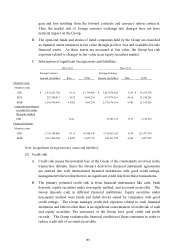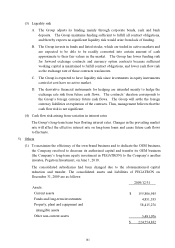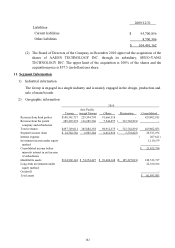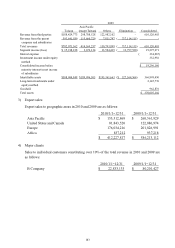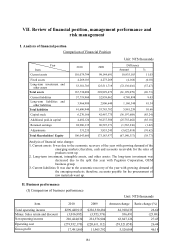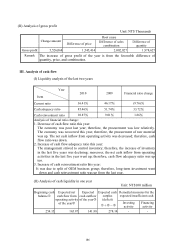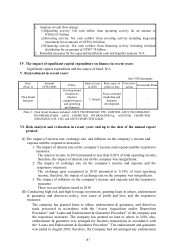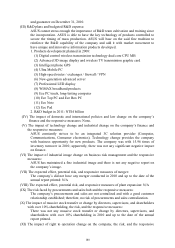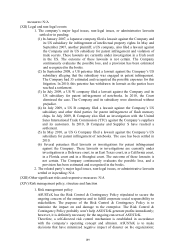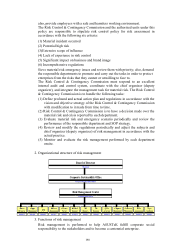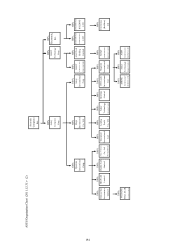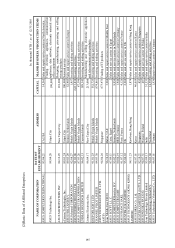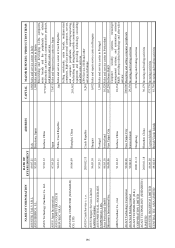Asus 2010 Annual Report Download - page 193
Download and view the complete annual report
Please find page 193 of the 2010 Asus annual report below. You can navigate through the pages in the report by either clicking on the pages listed below, or by using the keyword search tool below to find specific information within the annual report.189
189
measures: N/A
(XII) Legal and non-legal events:
1. The company’s major legal issues, non-legal issues, or administrative lawsuits
settled or in pending:
(1) In January 2007, a Japanese company filed a lawsuit against the Company and
its US subsidiary for infringement of intellectual property rights. In May and
September 2007, another plaintiff, a US company, also filed a lawsuit against
the Company and its US subsidiary for patent infringement and violation of
trade secrets. These lawsuits are currently under investigation in a Utah court
in the US. The outcome of these lawsuits is not certain. The Company
continuously evaluates the possible loss, and a provision has been estimated
and recognized in the books.
(2) In September 2008, a US patentee filed a lawsuit against the Company’s US
subsidiary alleging that the subsidiary was engaged in patent infringement.
The Company had 35 estimated and recognized the possible expenses for this
litigation. In 2010, this patentee has withdrawn its lawsuit as the parties have
reached a settlement.
(3) In July 2009, a US W company filed a lawsuit against the Company and its
US subsidiary for patent infringement of notebooks. In 2010, the Court
dismissed the case. The Company and its subsidiary were dismissed without
prejudice.
(4) In July 2009, a US B company filed a lawsuit against the Company’s US
subsidiary and other third parties for patent infringement of flash memory
chips. In July 2009, B Company also filed an investigation with the United
Sates International Trade Commission (‘ITC) against the Company’s suppliers
and its customers. In 2010, B Company and Supplier S have reached a
settlement.
(5) In May 2010, as US G Company filed a lawsuit against the Company’s US
subsidiary for patent infringement of notebooks. The case has been settled in
2010.
(6) Several patentees filed lawsuits or investigations for patent infringement
against the Company. These lawsuits or investigations are currently under
investigation in a Delaware court, in an East Texas court, in a California court,
in a Florida court and in a Shanghai court. The outcome of these lawsuits is
not certain. The Company continuously evaluates the possible loss, and a
provision has been estimated and recognized in the books.
2. The related party’s major legal issues, non-legal issues, or administrative lawsuits
settled or in pending: N/A
(XIII) Other significant risks and responsive measures: N/A
(XIV) Risk management policy, structure and function
1. Risk management policy
ASUSTeK has the Risk Control & Contingency Policy stipulated to secure the
ongoing concern of the enterprise and to fulfill corporate social responsibility to
stakeholders. The purpose of the Risk Control & Contingency Policy is to
minimize the impact on and damage to the enterprise. The Risk Control &
Contingency Policy probably won’t help ASUSTeK generate profits immediately;
however, it is definitely necessary for the ongoing concern of ASUSTeK.
Therefore, a self-directed risk control mechanism is established in accordance
with the company’s operating concept and altruism. ASUSTeK is to make
decisions that have minimized negative impact of disaster on the organization;



